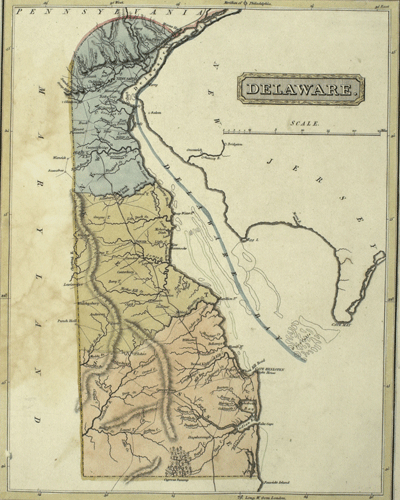Results navigation
2. Delaware 1789 Sheriff, Sussex County
3. Delaware 1791 Sheriff, Kent County
4. Delaware 1791 Sheriff, New Castle County
5. Delaware 1791 Sheriff, Sussex County
6. Delaware 1792 Sheriff, Kent County
7. Delaware 1792 Sheriff, New Castle County
8. Delaware 1794 Sheriff, Kent County
9. Delaware 1794 Sheriff, New Castle County
10. Delaware 1794 Sheriff, Sussex County
Results navigation

On December 7, 1787 the Delaware State Legislature, by a unanimous vote of 30 to 0, became the first state to ratify the newly proposed national Constitution.
When a new State Constitution was adopted in 1792, the office of State Executive, which had previously been called President and chosen by the Legislature, was changed to Governor, and became an elected position. The term of office was kept at three years.
Delaware with only three counties (New Castle, Kent and Sussex) had the fewest in the nation. They also had the smallest State Legislature, comprised of nine State Senators and twenty-one Representatives.
Each county had three Senators, serving for three years. Their terms were staggered, so that one Senator was elected every year from each county. The House of Representatives had twenty one members, seven from each county, and who were elected annually at large.
Congressional, State and County Elections were held simultaneously in early October. Delaware elected one Congressman from 1788 – 1810, two for 1812 – 1820, and then one again from 1822 onward. State offices elected by popular vote were Governor, State Senator and Representatives. County officials elected by popular vote were Levy Court Commissioners, Coroners and Sheriff.
The voting alignment of the three counties, with New Castle voting Republican and Sussex and Kent being Federalist, meant that the State Legislature was almost always controlled by Federalists. As a result, from 1792 to 1820 Delaware chose Federalist Presidential Electors, even in 1820 when all four electors gave their Vice Presidential votes to Daniel Rodney, a Federalist and former Governor.
The Legislature also selected United States Senators, and with the exception of Caesar A. Rodney, who was elected in 1822, all those chosen during this time period were Federalists.
Party competition began with the state elections of 1792 and continued virtually unabated until 1826, when the last Federalist Governor was elected. Despite the dominance of Federalists in the Legislature, the parties were fairly balanced in popular voting strength, with Republicans electing their candidate for Governor in 1801, 1810, 1820 and 1822 and Congressmen in 1792, 1794, 1802 and capturing one of their two seats in 1816, 1818 and 1820.
Delaware counties were broken down into Hundreds, which seem to be the equivalent of townships. By 1811 state election returns started to be reported by Hundreds, a procedure which began showing the tight cohesion in voting amongst Federalist and Republican tickets.
The Hundreds also elected local officials such as Assessors, Inspectors and Road Commissioners. These elections were held in September, before the state voted in October, and on occasion, if they were favorable to either party, these returns were reported in the newspapers.
Delaware, the first state in the Union was the last to elect a Federalist Governor.
Bibliography
Sheriff
Sheriff: executes civil and criminal process throughout the county, has charge of the jail and prisoners, attends courts and keeps the peace.
Oxford English Dictionary
In many states, the Sheriff was also an election official and their signature can be found on copies of Original Documents, ranging from state to federal elections. In Congressional districts having more than one county, the Sheriffs of each county would meet in a designated County Court House, compare the returns and certify the results. If the Sheriff of a county did not appear, the votes from his county would not be counted.
1787 - 1824: Alabama, Delaware, Georgia, Illinois, Indiana, Kentucky, Maryland, Mississippi, Missouri, New Jersey, New York, Ohio, Pennsylvania, South Carolina
Office Scope: County / City / District (Pennsylvania, South Carolina)
Role Scope: County / City / District (Pennsylvania, South Carolina)






